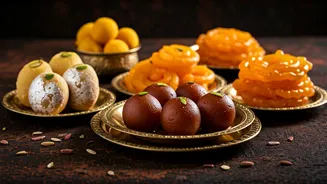Origins and Evolution
The roots of Indian street food can be traced back centuries, evolving alongside the growth of cities and trade routes. Historically, vendors set up stalls
near marketplaces, temples, and transportation hubs, catering to travelers and workers seeking quick, affordable meals. This informal dining scene provided a means of livelihood for many, offering a diverse range of dishes reflecting local produce and culinary traditions. Over time, regional specialties emerged, shaped by climate, ingredients, and cultural influences, adding to the richness of the street food landscape. Migration and trade also contributed to the spread and fusion of flavors, resulting in the diverse offerings seen today. The accessibility and affordability of street food have always been key to its popularity, allowing people from all walks of life to experience India's culinary heritage. The dishes often reflect a blend of simplicity and complexity, using readily available ingredients and time-honored cooking methods.
Regional Delights Unveiled
India's varied geography and climate have given birth to a remarkable array of street food specialties, with each region showcasing its unique culinary identity. In the north, you'll find the iconic *chole bhature*, a hearty combination of spicy chickpea curry and fluffy fried bread, alongside *aloo tikki*, potato patties served with chutneys. Moving to the east, Kolkata's *phuchka* (also known as *pani puri* in other regions) tantalizes with its crispy shells filled with flavored water and tamarind chutney. In western India, the flavors of Mumbai shine with *vada pav*, a potato fritter nestled in a bun, and *pav bhaji*, a vegetable medley served with bread. Heading south, you can enjoy *idli* and *dosa*, fermented rice cakes and crepes, accompanied by sambar and coconut chutney, a testament to South India’s rich culinary traditions. These are just glimpses of the vast diversity, where each dish reflects the region's specific ingredients, cooking methods, and cultural influences, creating a kaleidoscope of flavors across the country.
Savory Snacks Galore
The savory snacks of Indian street food are a feast for the senses, with textures and tastes that cater to all palates. *Samosas*, crispy, deep-fried pastries filled with spiced potatoes and peas, are ubiquitous across India. *Kachoris*, similar to samosas, but often filled with lentils and spices, offer a burst of flavor. *Aloo tikki*, as previously mentioned, are often enjoyed with a variety of chutneys, from mint-coriander to tamarind, adding a burst of freshness and sweetness. *Pani puri*, the ultimate street food experience, provides a delightful explosion of flavors and textures in every bite. Various *chaats*, such as *bhel puri* and *sev puri*, blend crispy elements with chutneys and other ingredients, offering a complex symphony of tastes. These savory snacks are often inexpensive and accessible, creating a culture of shared meals and social interaction. Each region boasts its own variations, ensuring a continuous adventure for those exploring the savory side of Indian street food.
Sweet Temptations Await
Indian street food also boasts a tempting selection of sweet treats, perfect for satisfying any sweet tooth. *Jalebis*, deep-fried batter swirls soaked in syrup, are a quintessential dessert found all over India, offering a sticky-sweet experience. *Gulab jamun*, milk-solid balls soaked in sugar syrup, provides a soft and comforting indulgence. *Kulfi*, a traditional Indian ice cream, offers a dense and creamy alternative to traditional ice cream, often flavored with cardamom, saffron, or nuts. *Rabri faluda* is another popular dessert, combining rabri (reduced sweetened milk) with vermicelli noodles and ice cream. Various types of *mithai* (sweets) are also available, including barfi, peda, and ladoo, each representing a unique blend of flavors and textures. From the sugary syrup of jalebis to the creamy richness of kulfi, the sweet treats of Indian street food provide a perfect ending to any culinary adventure, reflecting the celebratory spirit of Indian culture.
Safety and Hygiene
While Indian street food offers a delicious culinary experience, it’s also important to be aware of safety and hygiene considerations. The best practices involve choosing stalls with high customer turnover, which often indicates fresh food. Observing the vendor’s cleanliness, including the handling of food and the overall environment, is vital. Look for stalls where food is cooked to order, indicating freshness. In hot weather, avoid items that may have been sitting out for long periods, like pre-cut fruits or dairy products. Washing hands before eating and drinking bottled water are also important precautions. Many vendors now follow improved hygiene standards, and it is a good idea to consider your own tolerance to spices and flavors, especially if you are not used to them. Prioritizing these considerations will help you enjoy the delicious food while minimizing health risks and ensuring a safe and positive experience.
The Cultural Significance
Indian street food transcends mere sustenance, deeply intertwined with the cultural fabric of India. It acts as a social connector, drawing people from all walks of life together. Street food is often an affordable treat, available to everyone, and its popularity helps to sustain local economies. It’s also a powerful expression of regional identity, with each city and region promoting its unique food offerings. Food vendors often become local celebrities, sharing their culinary expertise. The experience also reflects a vibrant community, where meals are often shared in a lively atmosphere. Street food markets are often bustling hubs of activity, acting as places to socialize, experience culture, and create lasting memories. Street food plays a crucial role in maintaining India's unique character.
















